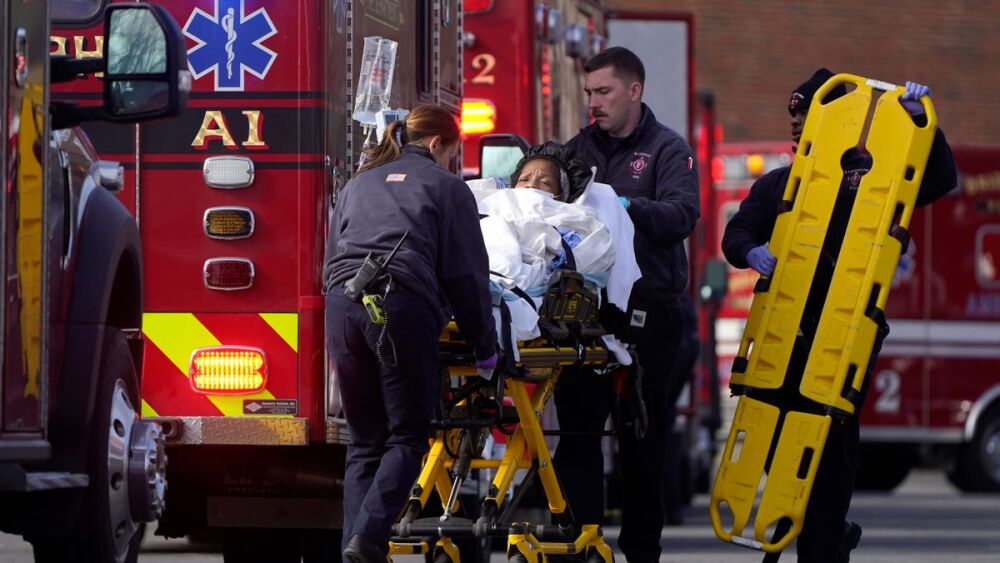This article originally appeared in the Article Bites blog of the National Association of EMS Physicians and is reprinted here with permission.
Article summary by Casey Patrick, MD (@cpatrick_89)
Article reviewed: Lemkes JS, Janssens GN, van der Hoeven NW, Jewbali LSD, et al. Coronary Angiography after Cardiac Arrest without ST-Segment Elevation. N Engl J Med. 2019 Apr 11;380(15):1397-1407.
Background. Let’s start with a brief overview of the evolution of care for OHCA post-ROSC. While it is generally accepted that post-ROSC patients with evidence of STEMI warrant emergent cardiac catheterization, the timing of coronary angiography for post-ROSC patients without acute ST elevation has been unclear. Based on retrospective data, approximately 25%-50% of VF/VT arrests without STEMI have acute coronary occlusion and ~2/3 have significant coronary disease. Additionally, early retrospective studies showed improved mortality and neurologic outcomes with early angiography in post-arrest patients with and without STEMI [2].
This led many to surmise that early angiography was indicated for all post-ROSC OHCA patients without a clear non-cardiac source. However, as with any retrospective data, there were numerous sources of bias in these early studies such as concern for the selection of only “well” patients for emergent catheterization and wide variations in angiography timing across the various retrospective studies. This brings us to the first randomized, prospective trial of emergent versus delayed angiography for post-ROSC OHCA patients presenting with shockable rhythms – The COACT trial.
Prospective and randomized: Finally!
COACT was a prospective, randomized, multi-center (19 hospitals), Dutch trial by Lemkes et al. published in NEJM. The study period was from January 2015 through July 2018. Ninety-day mortality was assessed as the primary outcome from over 500 post-arrest patients, without post-ROSC STEMI, randomized to immediate versus delayed angiography. All initial rhythms were shockable and patients were unconscious on ED arrival. Patients with STEMI on EKG, shock or obvious non-cardiac cause of the cardiac arrest were excluded. In the delayed coronary angiography group, coronary angiography was generally performed after neurologic recovery, with exception of patients who underwent urgent coronary angiography in advance of their planned procedure because they developed cardiogenic shock, recurrent life-threatening arrhythmias or recurrent ischemia during hospitalization (38 out 265 patients randomized to the delayed group). Coronary angiography was performed in 97.0% of the patients in the immediate group and 64.7% of patients in the delayed group.
There were no significant differences in 90-day survival between the immediate and delayed groups with a 64.5% survival in the immediate group as compared to a 67.2% survival in the delayed cath group. Overall, an acute thrombotic occlusion was found in 3.4% in the immediate angiography group and 7.6% in the delayed angiography group. The immediate group time to intervention averaged 45 minutes from ED arrival as opposed to angiography at 5 days in the delayed group. Without the gory details, the two groups were extremely similar from a demographic comparison standpoint. The immediate intervention group did have a slightly longer time to targeted temperature management goals and there were some minor variations between antiplatelet and GIIb/IIIa administration between groups. Otherwise, treatment between groups was quite uniform.
What about other clinical outcomes?
Mortality is not the only relevant outcome following out-of-hospital cardiac arrest. Indeed, it is possible to survive with compromised cardiac function which may impair quality of life or longer term survival. The trial investigators subsequently published a study of one-year outcomes of the COACT Randomized Clinical Trial [3]. Follow-up data was obtained on 522 of the 552 patients (94.6%) in the original trial. Outcomes were obtained by telephone interview by a study investigator who was blinded to the original treatment allocation. What they found? No significant difference in outcomes including myocardial infarction since index hospitalization (0.8% immediate vs. 0.4% delayed), hospitalization due to heart failure since index hospitalization (0.8% immediate vs. 0.4% delayed), ICD shock (20.4% in immediate vs. 16.2% delayed) or survival at 1 year (61.4% immediate vs. 64.0% delayed).
The questions?
This seems to be a large and sturdy nail in the coffin containing emergent angiography for OHCA patients without STEMI. Why doesn’t this study show what prior meta-analyses have? Are there reasons this study may not represent US patients? First, meta-analyses of retrospective data have just as much bias risk as any individual retrospective study. Secondly, while the rate of coronary disease in COACT was similar to past data in shockable arrest sans STEMI (~2/3), the rate of unstable lesions seen in COACT was much lower at ~20% with an “acute” thrombosis rate of only ~5%. Often the definitions of “unstable” and “acute” lesions are poorly defined, and the rate of these lesions are possibly higher in the US population as compared to the Dutch so unstable coronary disease prevalence differences across populations could have resulted in less benefit for immediate angiography in the COACT study. Finally, 38 of 172 of those in the delayed group underwent the procedure “urgently” due to deterioration (shock, elevated trop) so, not unexpectedly, crossover and decompensation did occur.
Don’t dig too much further in looking for holes in COACT though; TOMAHAWK came along in 2021 and further confirmed COACT [4]. TOMAHAWK included patients over 30 years of age with OHCA from both shockable and non-shockable rhythms without evidence of STEMI or evidence of non-cardiac etiology of arrest. Like the COACT trial, the trial also excluded patients with cardiogenic shock or life-threatening arrhythmias. This study found an increase in death from any cause and severe neurologic deficit amongst patients who underwent immediate coronary angiography rather than a delayed approach [Death: 54.0% immediate vs. 46.0% delayed, Hazard ratio 1.28 with 95% CI of 1.00-1.63); severe neurologic deficit: 18.8% immediate vs. 12.7% delayed, RR 1.48 with 95% CI 0.82-2.67).
The conclusion?
Best current, prospective evidence provides no evidence of benefit for immediate over delayed coronary angiography for post-ROSC OHCA patients without STEMI, cardiogenic shock or hemodynamically unstable arrhythmias. In this population, waiting until neurologic recovery reduces the number of procedures (and associated cost and resources) by 30% without negative impact on patient outcomes.
Edited by EMS MEd Editor Maia Dorsett (@maiadorsett)
References
- Lemkes JS, et al. Coronary Angiography after Cardiac Arrest without ST-Segment Elevation. N Engl J Med. 2019 Apr 11;380(15):1397-1407.
- Kern KB, et al; INTCAR-Cardiology Registry. Outcomes of Comatose Cardiac Arrest Survivors With and Without ST-Segment Elevation Myocardial Infarction: Importance of Coronary Angiography. JACC Cardiovasc Interv. 2015 Jul;8(8):1031-1040.
- Lemkes, J. S., Janssens, G. N., van der Hoeven, N. W., Jewbali, L. S., Dubois, E. A., Meuwissen, M. M., ... & van Royen, N. (2020). Coronary angiography after cardiac arrest without ST segment elevation: one-year outcomes of the COACT randomized clinical trial. JAMA cardiology, 5(12), 1358-1365.
- Desch S et al; TOMAHAWK Investigators. Angiography after Out-of-Hospital Cardiac Arrest without ST-Segment Elevation. N Engl J Med. 2021 Dec 30;385(27):2544-2553.



